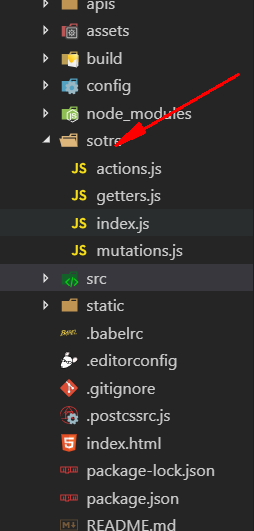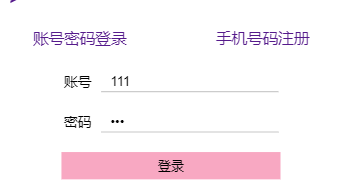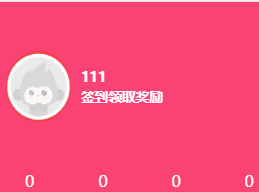vuex进行状态管理
巴啦啦小能量 人气:3vuex进行状态管理
首先学习vuex必须先知道vue原理
Vue是一个典型的MVVM框架,模型(Model)只是普通的JavaScript对象,修改它则视图(View)会自动更新。这种设计让状态管理变得非常简单而直观
Vue实现这种数据双向绑定的效果,需要三大模块:
Observer:能够对数据对象的所有属性进行监听,如有变动可拿到最新值并通知订阅者Compile:对每个元素节点的指令进行扫描和解析,根据指令模板替换数据,以及绑定相应的更新函数Watcher:作为连接Observer和Compile的桥梁,能够订阅并收到每个属性变动的通知,执行指令绑定的相应回调函数,从而更新视图
大概分为这么几类
vuex是什么呢
vuex是实现状态管理的工具 可以用来管理大型项目的工具
下面是一个简单的vuex的结构
index是主文件

//index//
import Vue from 'vue'
import Vuex from 'vuex'
import * as getters from './getters'
import * as actions from './actions'
import * as mutations from './mutations'
Vue.use(Vuex)
const state = {
username: '123'
}
const store = new Vuex.Store({
state,
getters,
actions,
mutations
})
export default store
进行一个简单地账户管理
//actions文件
// 给action注册事件处理函数。当这个函数被触发时候,将状态提交到mutations中处理
export function modifyAName({commit}, name) { // commit 提交;name即为点击后传递过来的参
return commit ('modifyAName', name)
}
// ES6精简写法
//export const modifyAName = ({commit},name) => commit('modifyAName', name)
//motations文件
// 提交 mutations是更改Vuex状态的唯一合法方法
export const modifyAName = (state, name) => { // A组件点击更改餐馆名称为 A餐馆
state.resturantName = name // 把方法传递过来的参数,赋值给state中的resturantName
}
//getters文件
// 获取最终的状态信息
export const resturantName = state => state.resturantName
//组件A/methods函数
sub(){
let log = document.querySelector("#log").value;
let reg = document.querySelector("#reg").value;
userapi("/users/userpsw",{name:log,psw:reg}, (mes) => {
if(mes === 1){
console.log(log)
this.$store.commit("modifyAName",log)
// 账户名称
console.log(this.$store.getters.resturantName)
document.querySelector(".text").innerHTML = "登录成功"
this.$router.push({ path: '/my' })
}else{
document.querySelector(".text").innerHTML = "登录失败"
}
})
},
组件B/computed
computed:{
username(){//调用username即可 {{username}}
return this.$store.getters.resturantName
}
},



vuex状态管理基本使用
通过npm安装vuex
npm install vuex --save
使用vuex
import Vuex from 'vuex'
Vue.use(Vuex)
//赋值给一个变量,然后引入
let store = new Vuex.Store({
...
})
//为了更好的维护,且体现模块化,可以写在别的js文件中,然后导入
import store from './store' //创建一个store文件夹,默认为文件夹下的index.js文件
new Vue({
...
store,
...
})使用vuex基本结构
new Vuex.Store({
//状态
state: {
count: 100
},
//将状态装饰,或刷选,以想要的结果输出
getters: {
hasUnit () {
return this.state.count.filter(count => count + 1)
}
},
//可以理解为变更状态的方法,第一个参数为state,可以再添加自定义参数,注意:只能进行同步
mutations: {
increment (state) {
state.count++
}
},
//可控制的提交mutation事件,弥补mutation无法异步
actions: {
increment (state) {
setTimeout(() =>
state.commit('increment'), 30)
}
}
})为了更好的维护,往往将store文件写成以下结构 ,名字自定义,但是需要知道每个文件的作用

index.js:主要作为导出store,作为汇总的文件state.js:作为定义的变量集合,作为一个对象导出getters.js:作为主要是获取state中变量值的方法,return出state相应的值,或者length等等的一些state变量的信息mutations-type.js: 作为一些方法等命名的变量,防止书写错误
![]()
mutaintions.js:存放修改state变量的同步方法,这里可以的方法名就是用了mutations-type.js中的变量命名,[object.value]这种方式是ES6中的语法

action.js:存放修改state变量的异步方法
在组件中引用,不使用mapXXXXX辅助函数情况下
state和getter:直接在computed计算属性中使用
computed: {
count () {
return this.$store.state.count
},
hasUnit () {
return this.$store.getters.hasUnit
}
}mutations和actions则被作为事件调用,可以放在methods,watch等等,有事件调用的时候都可以
methods: {
add () {
this.$store.commit('increment') // mutations使用commit调用
},
asyncAdd () {
this.$store.dispatch('increment') // actions使用dispatch调用
}
}通过mapXXXX辅助函数来引用
先确保组件中已导入vuex的相应辅助函数:用到哪个导入哪个
import { mapState } from 'vuex'
import { mapGetters } from 'vuex'
import { mapMutations } from 'vuex'
import { mapActions } from 'vuex'
//导入多个:ES6模块
import { mapState, mapGetters } from 'vuex'然后根据你的需求使用对应的辅助函数,前提是已经导入
computed: {
...mapState([
'count'
]),
...mapGetters([
'addUnit'
])
}
//使用this.count, this.addUnitmethods: {
...mapMutations([
'increment'
]),
...mapActions({
addNum: 'increment'
})
add () {
this.increment()
}
}
//可以被当做事件调用,为了避免命名冲突,可以使用重命名,需要使用{}而不是[]模块:Module
当项目很大的时候,很多版块在一起容易混淆,希望每个版块的信息归每个版块下面,易于维护
//局部模块引用的第一个参数state都是自己模块里的
const moduleA = {
state: { ... },
mutations: { ... },
actions: { ... },
getters: { ... }
}
const moduleB = {
state: { ... },
mutations: { ... },
actions: { ... }
}
const store = new Vuex.Store({
modules: {
a: moduleA,
b: moduleB
}
})以moduleA为例 ,可以新建一个JS文件,然后通过import导入到总的vuex管理中
const state = {
count: 1
};
const getters = {
get(state) {
return state.count;
}
};
const mutations = {
add(state) {
state.count++;
},
reduce(state) {
state.count--;
}
};
const actions = {
add: ({ commit }) => {
commit("add");
},
reduce: ({ commit }) => {
commit("reduce");
}
};
export default {
namespaced: true, // 使该模块带有命名空间,使它在命名上会按路径进行命名 如moduleA/state
state,
getters,
mutations,
actions
};在使用了模块后,我们可以通过以下方式获取,这里只用了辅助函数展示
computed: {
...mapState({
count: state => state.moduleA.count
}),
...mapGetters({
get: "moduleB/get"
})
}methods: {
...mapMutations(
'moduleA', {addA:'add', reduceB:'reduce'} // 重命名就用对象包裹
),
...mapActions(
'moduleA', ['add', 'reduce']
)
}如果想引用根目录下的状态,需要传入第三个参数
const moduleA = {
// ...
getters: {
addUnit (state, getters, rootState) { //rootState为根下的状态
return state.count + rootState.count
}
}
}以上为个人经验,希望能给大家一个参考,也希望大家多多支持。
加载全部内容